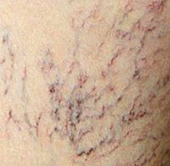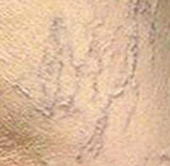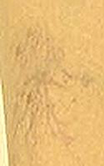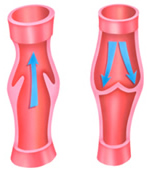
University Vascular Associates
Marina Laser Vein Center
Marina Laser Vein Center
4560 Admiralty Way - Suite 356
Marina Del Rey, CA 90292
Call us at: (310) 823-7314
Welcome to Marina Laser Vein Center! Our fellowship-trained vascular surgeons utilize the most advanced minimally invasive treatment of vein disease.
We look forward to meeting you and providing you with the best possible care!
Telangiectasias (spider veins) are dilated superficial veins. They are often found on the face and legs. The thin veins on the legs termed spider veins usually appear on the thighs and ankles. The veins on the face generally appear on the nose, chin or cheek area and often occur in rosacea. These veins are purple, blue or red and usually appear in three basic shapes: linear, branch-like or spider-shaped, with a dark center point.



Incidence and Causes
Nearly 70% of all women and 30% of men will develop some type of venous disorder. Spider veins result from reticular veins or truncal/saphenous insufficiency. If the patient has pain or swelling a duplex ultrasound is performed to make a complete diagnosis. If truncal/saphenous insufficiency is diagnosed, this condition should be treated prior to treatment of the spider veins.
Contributing factors include:
- Heredity
- Pregnancy
- Hormonal changes
- Being overweight
- Standing or sitting for prolonged of time
- Advancing age
- Trauma
- Sun-exposure for veins on the face
Anatomy
Since humans walk upright, our leg veins contain valves that normally allow one-way blood flow from the feet up to the heart. They close and prevent backward blood flow when resting in the standing position. When the valves fail, there is backward blood flow (venous “insufficiency” or “reflux”) that results in very high venous pressure. Because veins have very thin walls, this high pressure causes significant stretching and elongation – resulting in the formation of varicose and spider veins.


Pre-Procedure Protocol
Skin pigmentation can impact the effectiveness of any laser; therefore the patient should have no sun exposure four weeks prior to treatment to guard against blistering and scarring.Although discomfort is mild, some form of cooling will be used to increase the patient’s comfort. Cooling may be achieved through the use of ice, a cool air device or topical anesthetic. The duration and number of sessions will vary depending on the severity of the spider veins and their location. Many facial veins can be treated in one session; however, most conditions on the leg require three to five treatments to ensure that all spider veins are treated. These treatments are spaced four to six weeks apart.
Unlike most physicians who use only sclerotherapy, our doctors use the double injury method when treating spider veins on the leg. This technique treats the spider veins with the D940 SkinPulse S laser, followed by an injection of sclerosing solution into the associated reticular or “feeder” vein. Laser energy is applied first through a hand piece that is very small and lightweight. Spot sizes are easily interchangeable and come in 0.5, 1.0, and 1.5 millimeter sizes, depending on the size of the veins. By injuring the veins with the laser first, the vein spasms and less sclerotherapy is required. The benefit of the double injury method over sclerotherapy alone is a quicker resolution and a significant decrease in the risk of skin staining. Staining appears as brownish discoloration on the skin. (See Alternative Treatment Options Below.)
Post Procedure Protocol
Once the procedure is completed, it is recommended that compression stockings be worn for three to five days.As with any procedure, some mild side-effects might occur. These side effects include slight redness to the skin tone or mild swelling in the treated area.
Common recommendations for the patient:
- Stay out of the sun and tanning beds for 4 weeks before and after surface laser treatment
- Wear compression stockings for a minimum of three to five days
- Abstain from high impact activities such as running or step aerobics for three weeks
- Walk at a moderate pace, as it will aid in the healing process


